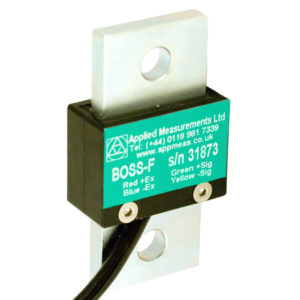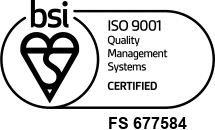
This weighing approach is cost-effective and quick to install, causes a minimum of production downtime and is ideal as a retrofitted system. The BOSS bolt-on sensor is a well-proven robust product consisting of a strain-gauged element encased in a protective housing. It is simply bolted to a structural member of the silo and deflects under the changing weight conditions, to give a varying electrical output relative to the load.
Bob Davies, general manager at Applied Measurements comments “with more than 25 years experience of bolt-on sensors, we assess the suitability of this method of measurement for each individual enquiry, including an on-site survey if required. This ensures the feasibility of a successful installation at the outset and we will commit to the accuracy likely to be achievable”. The very first consideration is the available stress for the sensor to measure and this is broadly dependent on the load applied and the design of the supporting structure it is mounted on.
Bolt-on systems are more than adequate for the majority of vessel weighing or level monitoring systems, where accuracy in the order of 1% – 2% is acceptable. We bolt the standard transducers to a suitable supporting member such as a leg, girder, channel or pipe. However, in some applications custom profiled mounting blocks may be required to suit the profile of the supporting steelwork.
For a system to be viable the load to be measured should be between 3000psi and 10,000psi. The accuracy achieved depends on a number of factors, but most significantly the amount of available strain to be measured.
Each BOSS sensor has an average sensitivity of 1.7mV/V for 10,000PSI.
As a general rule, sensors mounted internally will give the best results. With external systems, there will often be a margin of error due to zero shift, which is a result of differential expansion due to solar radiation but even this can be nullified to an extent. The accuracy achieved will be very dependent on the positioning of the sensor on the steelwork.
Accuracy Bands
- 3,000 – 5,000 PSI gives +/- 2 to 3% or better
- 5,000 – 7,500 PSI gives +/- 1 to 2% or better
- 7,500 – 10,000 PSI gives +/- 1%
Typical Application
A 220T cement silo on a 6-leg pipe section frame, giving 6000PSI total available signal. Our customer required the best accuracy for batching to supply ships and road tankers. As the available signal was good but not exceptional, we suggested 2x BOSS bolt-on sensors per leg to minimise errors and maximise accuracy. The result is that the customer can batch to ships +/- 1Tonne in 100T and +/-0.5Tonne in 30T. To minimise the effect of temperature, each Bolt-on sensor is fully insulated after installation
Suitable instrumentation to accompany the bolt-on sensors includes mains or battery-operated digital displays, local amplifiers allowing the signals to be monitored in a control room or a telemetry system for wireless monitoring via a remote hand-held receiver or a control room PC system.
For more information on the range of BOSS sensors please visit our bolt-on load cells page, or call us on 0118 981 7339 or email: [email protected]




